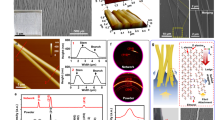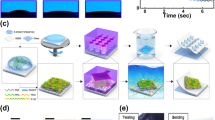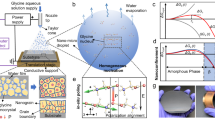Abstract
Piezoelectric poly-L-lactide (PLLA) films are highly applicable for designing soft electronics in biomedicine. However, due to a lack of reactive side-chain groups, PLLA is characterized by a chemically inert and hydrophobic surface. Although compatible with biological environments, this polymer has very poor interactions with cells. This work is the first report on piezoelectric PLLA films with hydrophilic surfaces. We performed a systematic study that correlated processing parameters (drawing ratio, drawing temperature, drawing rate) with postprocessing steps (annealing and etching) to produce active, hydrophilic, piezoelectric PLLA surfaces. During processing, the optimal drawing ratio, temperature and rate increase the crystallinity and crystallite size and provide chain orientation. Postprocessing annealing and etching afford further improvements in structural properties and optimized surface characteristics. Consequently, the resulting PLLA films possess piezoelectric properties in combination with hydrophilic surfaces and specifically patterned topography. Using this approach, we designed active PLLA films with high potential for strong interactions with cells in further biomedical applications, including exploring the effect of piezoelectricity on cell proliferation. This study provides novel insight into designing synthetic piezoelectric polymers with significantly improved interactions with cells and tissues, which are particularly important for their application in biomedicine.
This is a preview of subscription content, access via your institution
Access options
Subscribe to this journal
Receive 12 print issues and online access
$259.00 per year
only $21.58 per issue
Buy this article
- Purchase on Springer Link
- Instant access to full article PDF
Prices may be subject to local taxes which are calculated during checkout









Similar content being viewed by others
References
Curry EJ, Ke K, Chorsi MT, Wrobel KS, Miller AN, Patel A, Kim I, Feng J, Yue L, Wu Q, Kuo C-L, Lo KW-H, Laurencin CT, Ilies H, Purohit PK, Nguyen TD. Biodegradable piezoelectric force sensor. Proc Natl Acad Sci USA. 2018;115:909–14. https://doi.org/10.1073/pnas.1710874115.
Lagarón J-M (editor). Polylactic acid (PLA) nanocomposites for food packaging applications. In: Multifunctional and nanoreinforced polymers for food packaging, Woodhead Publishing, Cambridge, UK; 2011. p. 485–97. https://doi.org/10.1533/9780857092786.4.485.
Miyazaki H, Kinoshita M, Saito A, Fujie T, Kabata K, Hara E, Satoshi O, Takeoka S, Saitoh D. An ultrathin poly(L-lactic acid) nanosheet as a burn wound dressing for protection against bacterial infection. Wound Repair Regen. 2012;20:573–9. https://doi.org/10.1111/j.1524-475X.2012.00811.x.
Ikada Y, Shikinami Y, Hara Y, Tagawa M, Fukada E. Enhancement of bone formation by drawn poly(L-lactide). J Biomed Mater Res. 1996;30:553–8. https://doi.org/10.1002/(SICI)1097-4636(199604)30:4<553:AID-JBM14>3.0.CO;2-I.
Abd Alsaheb RA, Aladdin A, Othman NZ, Abd Malek R, Leng OM, Aziz R, Enshasy HAEl. Recent applications of polylactic acid in pharmaceutical and medical industries. J Chem Pharm Res. 2015;7:51–63.
Lotz B. Crystal polymorphism and morphology of polylactides. In: Di Lorenzo ML, Androsch R, editors. Synthesis, structure and properties of poly(lactic acid). Springer, Cham, Switzerland; 2017. p. 273–302. https://doi.org/10.1007/12_2016_15.
Takahashi K, Sawai D, Yokoyama T, Kanamoto T. Crystal transformation from the a- to the b-form upon tensile drawing of poly (L-lactic acid), 45 (2004) 4969–76. https://doi.org/10.1016/j.polymer.2004.03.108.
Chen X, Kalish J, Hsu SL. Structure evolution of a α’-phase poly(lactic acid). J Polym Sci Part B Polym Phys. 2011;49:1446–54. https://doi.org/10.1002/polb.22327.
Fukada E. History and recent progress in piezoelectric polymers. IEEE Trans Ultrason, Ferroelectr, Freq Control. 2000;47:1277–90.
Lovell CS, Fitz-Gerald JM, Park C. Decoupling the effects of crystallinity and orientation on the shear piezoelectricity of polylactic acid. J Polym Sci Part B Polym Phys. 2011;49:1555–62. https://doi.org/10.1002/polb.22345.
Singh AA, Wei J, Herrera N, Geng S, Oksman K. Synergistic effect of chitin nanocrystals and orientations induced by solid-state drawing on PLA-based nanocomposite tapes. Compos Sci Technol. 2018;162:140–5. https://doi.org/10.1016/j.compscitech.2018.04.034.
Singh AA, Geng S, Herrera N, Oksman K. Aligned plasticized polylactic acid cellulose nanocomposite tapes: effect of drawing conditions. Compos Part A Appl Sci Manuf 2018;104:101–7. https://doi.org/10.1016/j.compositesa.2017.10.019.
Tajitsu Y. Basic study of controlling piezoelectric motion of chiral polymeric fiber. Ferroelectrics. 2009;389:83–94. https://doi.org/10.1080/00150190902987871.
Fukada E. New piezoelectric polymers. Jpn J Appl Phys. 1998;37:2775–80. https://doi.org/10.1143/JJAP.37.2775.
Zareidoost A, Yousefpour M, Ghaseme B, Amanzadeh A. The relationship of surface roughness and cell response of chemical surface modification of titanium. J Mater Sci Mater Med. 2013;23:1479–88. https://doi.org/10.1007/s10856-012-4611-9.
Tandon B, Blaker JJ, Cartmell SH. Piezoelectric materials as stimulatory biomedical materials and scaffolds for bone repair. Acta Biomater. 2018;73:1–20. https://doi.org/10.1016/j.actbio.2018.04.026.
Tham CY, Abdul Hamid ZA, Ahmad Z, Ismail H. Surface modification of poly(lactic acid) (PLA) via alkaline hydrolysis degradation. Adv Mater Res. 2014;970:324–7. https://doi.org/10.4028/www.scientific.net/AMR.970.324.
Yanagida H, Okada M, Masuda M, Ueki M, Narama I, Kitao S, Koyama Y, Furuzono T, Takakuda K. Cell adhesion and tissue response to hydroxyapatite nanocrystal-coated poly (L -lactic acid) fabric. J Biosci. 2009;108:235–43. https://doi.org/10.1016/j.jbiosc.2009.04.003.
Adar F, Noether H. Raman microprobe spectra of spin-oriented and drawn filaments of poly (ethylene terephthalate). Polymers. 1985;26:1935–43. https://doi.org/10.1016/0032-3861(85)90171-5.
Farah S, Anderson DG, Langer R. Physical and mechanical properties of PLA, and their functions in widespread applications—a comprehensive review. Adv Drug Deliv Rev. 2016;107:367–92. https://doi.org/10.1016/j.addr.2016.06.012.
Bernard F, Gimeno L, Viala B, Gusarov B, Cugat O. Direct piezoelectric coefficient measurements of PVDF and PLLA under controlled strain and stress. Proceedings. 2017;1:335 https://doi.org/10.3390/proceedings1040335.
Turner JF, Riga A, O’Connor A, Zhang J, Collis J. Characterization of drawn and undrawn poly-L-lactide films by differential scanning calorimetry. J Therm Anal Calorim. 2004;75:257–68. https://doi.org/10.1023/B:JTAN.0000017347.08469.b1.
Chen Z, Zhang S, Wu F, Yang W, Liu Z, Yang M. Motion mode of poly(lactic acid) chains in film during strain-induced crystallization. J Appl Polym Sci. 2016;133:1–10. https://doi.org/10.1002/app.42969.
Larrañaga A, Lizundia E. Strain-induced crystallization. In: Thomas S, Arif PM, Gowd B, Kalarikkal N, editors. Crystallization in multiphase polymer systems. 1st ed., Elsevier, Amsterdam, Netherlands; 2018. p. 471–508. https://doi.org/10.1016/B978-0-12-809453-2.00015-3.
Yoshida M, Onogi T, Onishi K, Inagaki T, Tajitsu Y. High piezoelectric performance of poly(lactic acid) film manufactured by solid-state extrusion. Jpn J Appl Phys. 2014;53:PC02-1–PC02-6. https://doi.org/10.7567/JJAP.53.09PC02.
Kister G, Cassanas G, Vert M, Pauvert B, Térol A. Vibrational analysis of poly(L‐lactic acid). J Raman Spectrosc. 1995;26:307–11. https://doi.org/10.1002/jrs.1250260409.
Vasanthan N, Ly O. Effect of microstructure on hydrolytic degradation studies of poly (l-lactic acid) by FTIR spectroscopy and differential scanning calorimetry. Polym Degrad Stab. 2009;94:1364–72. https://doi.org/10.1016/j.polymdegradstab.2009.05.015.
Wang Y, Zhang H, Li M, Cao W, Liu C, Shen C. Orientation and structural development of semicrystalline poly(lactic acid) under uniaxial drawing assessed by infrared spectroscopy and X-ray diffraction. Polym Test. 2015;41:163–71. https://doi.org/10.1016/j.polymertesting.2014.11.010.
Rangari D, Vasanthan N. Study of strain-induced crystallization and enzymatic degradation of drawn poly (l-lactic acid)(PLLA) films. Macromolecules. 2012;45:7397–403. https://doi.org/10.1021/ma301482j.
Meaurio E, Zuza E, López-Rodríguez N, Sarasua JR. Conformational behavior of poly(L-lactide) studied by infrared spectroscopy. J Phys Chem B. 2006;110:5790–5800. https://doi.org/10.1021/jp055203u.
Quéré D. Rough ideas on wetting. Physica A. 2002;313:32–46.
Sun SP, Wei M, Olson JR, Shaw MT. Alkali etching of a poly(lactide) fiber, ACS Appl Mater Interfaces. 2009. https://doi.org/10.1021/am900227f.
Ochiai T, Eiichi Fukada. Electromechanical properties of poly-L-lactic acid. Jpn J Appl Phys. 1998;37:3374–6. https://doi.org/10.1143/JJAP.37.3374.
Meng S, Rouabhia M, Zhang Z. Electrical stimulation in tissue regeneration, In: Appl Biomed Eng. 2011. https://doi.org/10.5772/18874.
Wang ET, Zhao M. Regulation of tissue repair and regeneration by electric fields. Chin J. Traumatol.(English Ed.) 2010. https://doi.org/10.3760/cma.j.issn.1008-1275.2010.01.011.
Acknowledgements
The authors are grateful to David Fabijan and Damjan Vengust, Advanced Materials Department, Jozef Stefan Institute, for the piezoelectric and Raman spectroscopy measurements, respectively. We also acknowledge the CENN Nanocenter for the use of the NTEGRA Spectra I confocal Raman spectrometer. The work has been funded by the Slovenian Research Agency (ARRS) (grants J2-8169 and PR-08338).
Author information
Authors and Affiliations
Corresponding author
Ethics declarations
Conflict of interest
The authors declare that they have no conflict of interest.
Additional information
Publisher’s note Springer Nature remains neutral with regard to jurisdictional claims in published maps and institutional affiliations.
Rights and permissions
About this article
Cite this article
Udovč, L., Spreitzer, M. & Vukomanović, M. Towards hydrophilic piezoelectric poly-L-lactide films: optimal processing, post-heat treatment and alkaline etching. Polym J 52, 299–311 (2020). https://doi.org/10.1038/s41428-019-0281-5
Received:
Revised:
Accepted:
Published:
Issue Date:
DOI: https://doi.org/10.1038/s41428-019-0281-5



